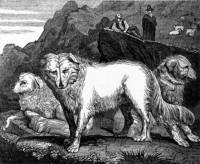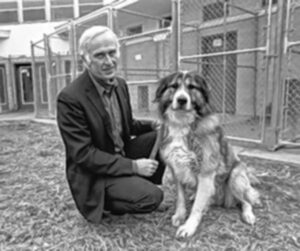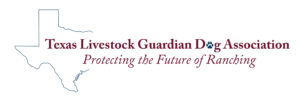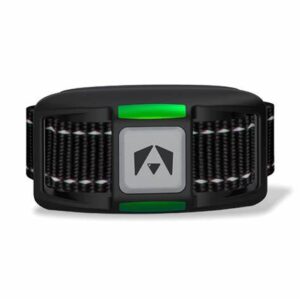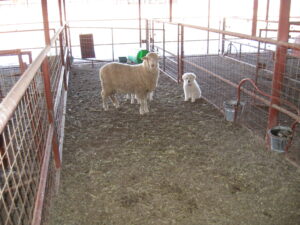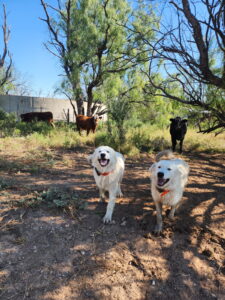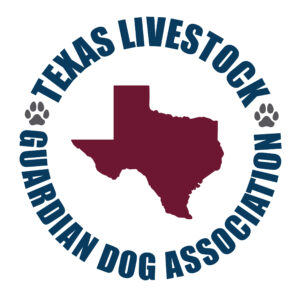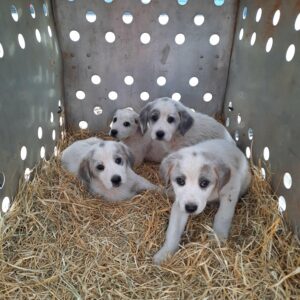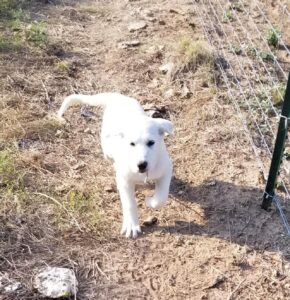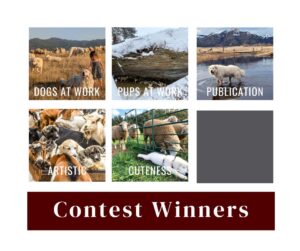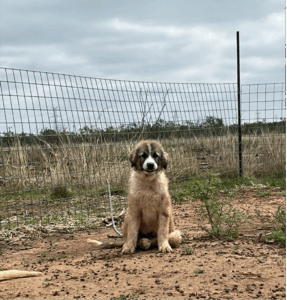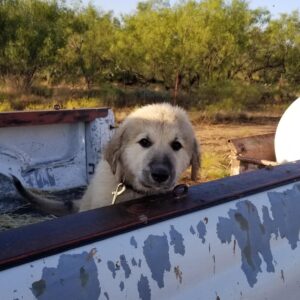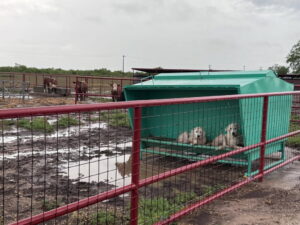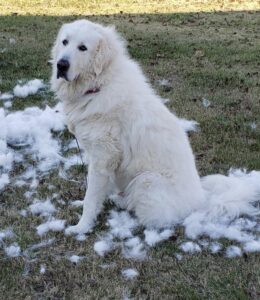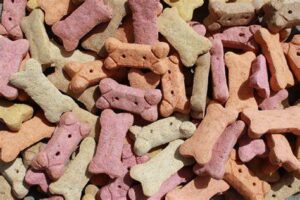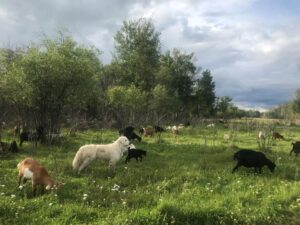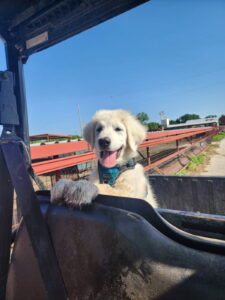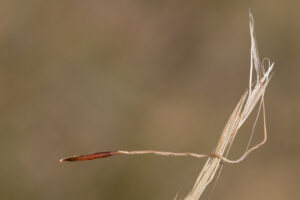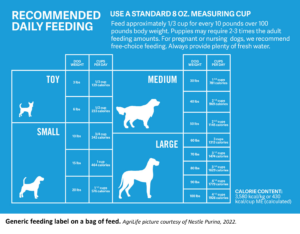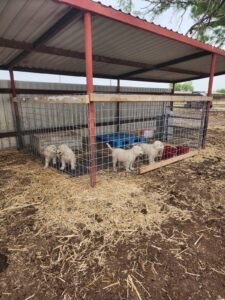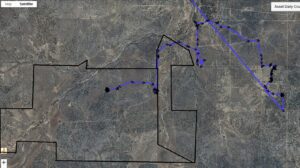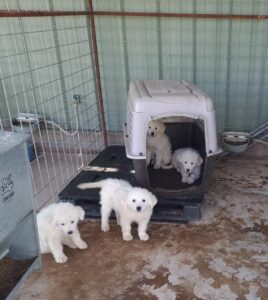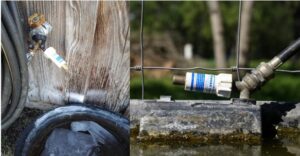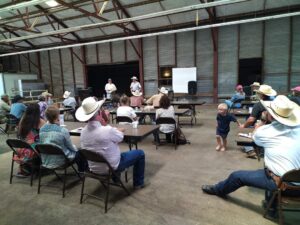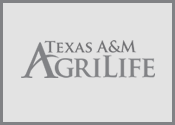
I decided to write a second part to the Christmas Guardian story this year. If you missed the last one, please go back to our December 2024 issue. So many of you reached out to me last year about the story that I decided to make it an annual article each December. I hope you enjoy Gus the LGD’s travels again this year. We continue our normal format and finish our two-part article on “What is a Livestock Guardian Dog” in our January issue! I hope everyone has a Merry Christmas and a great New Year’s!
The Christmas Guardian: Year Two
Snow once again blanketed the rolling hills of the Harris Ranch, covering the fences and cedar posts in a glittering coat of white. The wind carried the scent of hay and livestock, and in the distance, a deep, steady bark echoed through the crisp December air.
It was Gus.
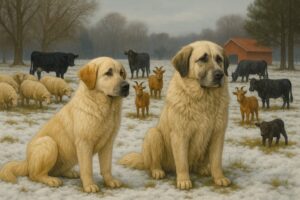
Gus and his mentor Duke on the Harris Ranch protecting livestock. The AgriLife picture is courtesy of ChatGPT and Costanzo, 2025.
Now a year older, Gus had grown into a powerful, confident livestock guardian dog. His thick white coat rippled in the cold wind, and his deep bark carried authority. He was no longer the unsure pup of last winter; he was now the primary protector of the ranch.
Duke, his old mentor, watched proudly from his resting spot near the barn. The old Great Pyrenees had retired; his limp still slowed him down, but he kept a watchful eye on Gus and the pastures. “You’ve come a long way, kid,” Duke rumbled. “Just don’t let your guard down. Winter brings more than snow.”
Gus wagged his tail and gave a confident woof. “I’ve got it, Duke. You rest easy.”
The ranch had grown since last Christmas. The Harris family now raised not only cattle but also a flock of sheep and a small herd of goats. Gus took to them quickly, spending his nights under the stars, his white fur blending perfectly with the flock.
On Christmas Eve, the ranch was alive with lights and laughter. Mrs. Harris was baking pies again, and Mr. Harris was finishing chores in the barn, humming a Christmas tune. The children were excitedly hanging stockings by the fire. It looked like it was a peaceful holiday.
But out in the pastures, danger was stirring. The cold had driven coyotes and even a lone mountain lion closer to the ranch. Gus had been hearing strange cries for two nights in a row and had been on edge. That evening, as snow began to fall thick and fast, Gus caught a scent that made his fur bristle.
He lifted his head, ears sharp. Something was near the goat pen.
Without hesitation, Gus bolted across the snowy field. The sheep huddled close together, nervous but trusting their guardian. As Gus neared the pen, he saw movement, two coyotes creeping low under the fence while the mountain lion circled above the ridge, waiting for the right moment to pounce.
Gus let out a thunderous bark that shattered the silence. The coyotes froze, eyes glowing in the dark. The mountain lion snarled, startled by the bold sound. Gus charged forward, his deep bark echoing through the valley. He positioned himself between the flock and the predators, his stance unflinching.
From the barn, Duke heard the noise and hobbled to the door. He barked deeply, adding his voice to the fight. “Hold your ground, Gus! Make them think you’re bigger than the mountain itself!”
Gus barked again and again, refusing to back down. The coyotes yipped and scattered into the snow, while the mountain lion hesitated, then turned and vanished into the darkness.
Moments later, Mr. Harris came running with a rifle and a flashlight. “Gus! What’s happening?” he called, scanning the snow. When he saw Gus standing tall, the sheep and goats safely behind him, relief covered his face.
“You did it again, boy,” he said, kneeling to rub Gus’s thick neck. “You saved Christmas for all of us.”
Back at the barn, Duke greeted Gus with a proud wag of his tail. “I told you, you were ready,” he said with a warm, rumbling chuckle. Gus leaned against him, tired but happy.
When morning came, the ranch sparkled in the sunlight. The livestock grazed calmly, and the Harris family gathered around Gus and Duke with extra treats and warm praise. Mrs. Harris even slipped a bow around Gus’s neck, laughing. “Our Christmas hero, two years running.”
That night, as the fire crackled and snowflakes danced outside, Gus lay beside Duke near the hearth. Duke’s head rested on his paws, his eyes half closed. “You’ve got it from here, kid,” he murmured.
Gus gave a soft bark and looked toward the window, where the stars glowed over the peaceful ranch he’d sworn to protect. Christmas was safe again, and as long as he stood guard, it always would be.
In the distance, the faint words of “Merry Christmas to all, and to all a good night!” could be heard. Until next year, Merry Christmas, everyone!
In closing
Do you have any feedback about this article, or would you like to propose topics for future articles, webinars, or workshops? Please do not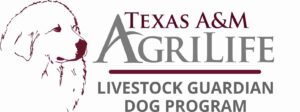 hesitate to contact me at bill.costanzo@ag.tamu.edu or 325-657-7311.
hesitate to contact me at bill.costanzo@ag.tamu.edu or 325-657-7311.
Are you seeking information on LGDs? Please visit our website, which features factsheets, global research on LGDs, and case studies we have conducted.
Follow us on our social media platforms and share them with your friends and family!
Facebook, Instagram, YouTube: @TAMUlivestockguarddog
 Be sure to visit the Texas LGD Association online! You can follow the organization on Facebook or YouTube under @TexasLGDAssociation or visit its website.
Be sure to visit the Texas LGD Association online! You can follow the organization on Facebook or YouTube under @TexasLGDAssociation or visit its website.
Texas A&M AgriLife provides equal opportunities in its programs and employment to all persons, regardless of race, color, sex, religion, national origin, disability, age, genetic information, veteran status, sexual orientation, or gender identity. The Texas A&M University System, U.S. Department of Agriculture, and the County Commissioners Courts of Texas Cooperating.


